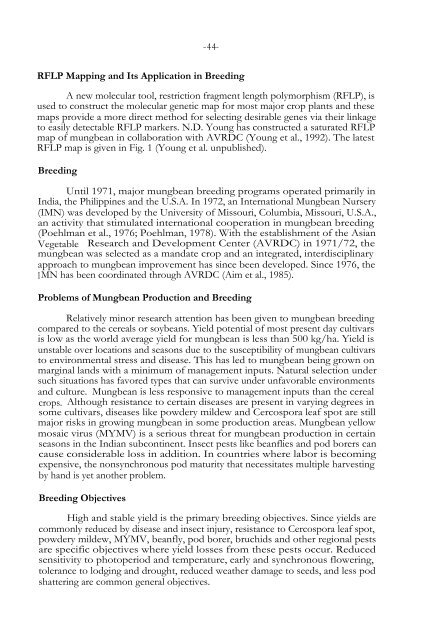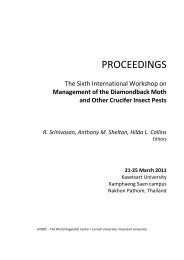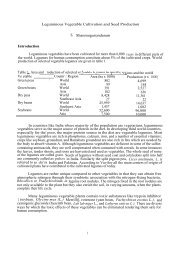MUNGBEAN VARIETAL IMPROVEMENT S. Shanmugasundaram
MUNGBEAN VARIETAL IMPROVEMENT S. Shanmugasundaram
MUNGBEAN VARIETAL IMPROVEMENT S. Shanmugasundaram
You also want an ePaper? Increase the reach of your titles
YUMPU automatically turns print PDFs into web optimized ePapers that Google loves.
-44-<br />
RFLP Mapping and Its Application in Breeding<br />
A new molecular tool, restriction fragment length polymorphism (RFLP), is<br />
used to construct the molecular genetic map for most major crop plants and these<br />
maps provide a more direct method for selecting desirable genes via their linkage<br />
to easily detectable RFLP markers. N.D. Young has constructed a saturated RFLP<br />
map of mungbean in collaboration with AVRDC (Young et al., 1992). The latest<br />
RFLP map is given in Fig. 1 (Young et al. unpublished).<br />
Breeding<br />
Until 1971, major mungbean breeding programs operated primarily in<br />
India, the Philippines and the U.S.A. In 1972, an International Mungbean Nursery<br />
(IMN) was developed by the University of Missouri, Columbia, Missouri, U.S.A.,<br />
an activity that stimulated international cooperation in mungbean breeding<br />
(Poehlman et al., 1976; Poehlman, 1978). With the establishment of the Asian<br />
Vegetable Research and Development Center (AVRDC) in 1971/72, the<br />
mungbean was selected as a mandate crop and an integrated, interdisciplinary<br />
approach to mungbean improvement has since been developed. Since 1976, the<br />
IMN has been coordinated through AVRDC (Aim et al., 1985).<br />
Problems of Mungbean Production and Breeding<br />
Relatively minor research attention has been given to mungbean breeding<br />
compared to the cereals or soybeans. Yield potential of most present day cultivars<br />
is low as the world average yield for mungbean is less than 500 kg/ha. Yield is<br />
unstable over locations and seasons due to the susceptibility of mungbean cultivars<br />
to environmental stress and disease. This has led to mungbean being grown on<br />
marginal lands with a minimum of management inputs. Natural selection under<br />
such situations has favored types that can survive under unfavorable environments<br />
and culture. Mungbean is less responsive to management inputs than the cereal<br />
crops. Although resistance to certain diseases are present in varying degrees in<br />
some cultivars, diseases like powdery mildew and Cercospora leaf spot are still<br />
major risks in growing mungbean in some production areas. Mungbean yellow<br />
mosaic virus (MYMV) is a serious threat for mungbean production in certain<br />
seasons in the Indian subcontinent. Insect pests like beanflies and pod borers can<br />
cause considerable loss in addition. In countries where labor is becoming<br />
expensive, the nonsynchronous pod maturity that necessitates multiple harvesting<br />
by hand is yet another problem.<br />
Breeding Objectives<br />
High and stable yield is the primary breeding objectives. Since yields are<br />
commonly reduced by disease and insect injury, resistance to Cercospora leaf spot,<br />
powdery mildew, MYMV, beanfly, pod borer, bruchids and other regional pests<br />
are specific objectives where yield losses from these pests occur. Reduced<br />
sensitivity to photoperiod and temperature, early and synchronous flowering,<br />
tolerance to lodging and drought, reduced weather damage to seeds, and less pod<br />
shattering are common general objectives.

















